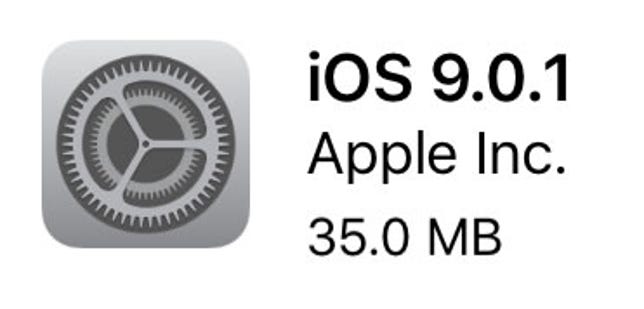
Screenshot by Lance Whitney/CNET
A week after pushing out iOS 9, Apple has released the first set of bug fixes for its new mobile software.
Available as of Wednesday, iOS 9.0.1 makes several corrections, most notably to the “Slide to Upgrade” item. Some users had found that their devices would freeze at the Slide to Upgrade screen when attempting to install iOS 9.
In the release notes for the new update, Apple mentions fixes for three other issues, including one in which alarms and timers could fail to play, another in which pausing a video in the Safari browser or Photos feature might distort the paused frame and one more in which users with custom APN (Access Point Name) setups might lose data over a cellular connection.
A bug fix only one week into the launch of a new version of iOS isn’t a bad thing. It shows that Apple is trying to keep on top of nagging glitches, which are inevitable in any new software, especially after millions of users get their hands on it. But Apple certainly has to avoid the problems it ran into with iOS 8 where each bug fix seemed to introduce more bugs that needed fixing. In its initial release at this time last year, iOS 8 earned a reputation as being unstable and unreliable.
Adoption of iOS 9 is breaking records, according to Apple. On Monday, the company said that the latest version of its mobile software was already on more than 50 percent of all iPhones, iPads and iPod Touches. Apple measures iOS adoption by on the number of devices that visit the Apple Store on a given date.
The iOS 9 software offers a number of enhancements and new features. For instance, the Siri voice assistant can now remind you of calendar appointments, while the Notes app lets you create checklists, draw sketches and add attachments. The Apple Maps app offers more mass-transit information for some major cities.
In addition, iOS 9 promises better battery life with a low-power mode that kicks in when you run below a 20 percent battery charge. A new split-screen feature lets you view two apps side by side if you’re using the iPad Air 2 or later iPads.
You can update your iPhone, iPad or iPod Touch to iOS 9.0.1 directly through the Software Update screen under Settings or by launching iTunes, selecting your device and then clicking on the Update button.
So are all the bugs in iOS 9 fixed with this latest update? Apparently not, at least not according to a couple of videos posted on YouTube.
Two videos — one posted last Friday by a fellow named Jose Rodriguez and the other on Saturday by an account called EverythingApplePro — document the same flaw. Both show how someone can sneak past the lock screen on an iOS device to gain access to your photos and contacts. The hack requires a series of maneuvers in which you have to enter incorrect passcodes, talk to the device’s Siri voice assistant and add a new clock. So it’s not something the average person would know how to do (unless, of course, they follow the now public videos). But it’s a security hole nonetheless.
The hack was substantiated by blog site AppleInsider, which said that iOS devices with passcodes of four or six digits are vulnerable, while those with longer alphanumeric passwords are safe. With iOS 9, Apple tried to strengthen security by requiring six-digit passcodes, which you’ll discover if you attempt your change your existing four-digit code. The option to create an alphanumeric password as an alternative has been built into iOS for many years. To set that up, click on the link for Passcode options, and you’ll see a setting to create a custom alphanumeric code.
Beyond setting up an alphanumeric password, the only workaround suggested so far is to disable access to Siri when your iOS device is locked. You can do this by going into Settings and then Touch ID and Passcode. Scroll down the screen until you see the section called “Allow Access when Locked” and turn off the option for Siri.
Apple did not immediately respond to CNET’s request for comment.
(Via Tech 2)




